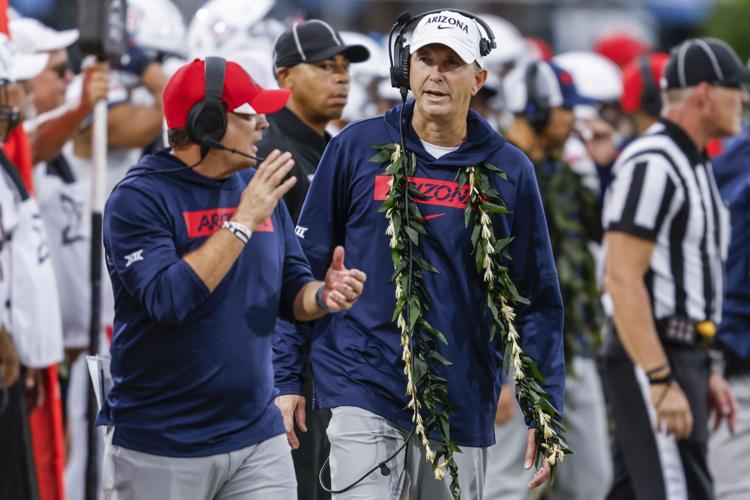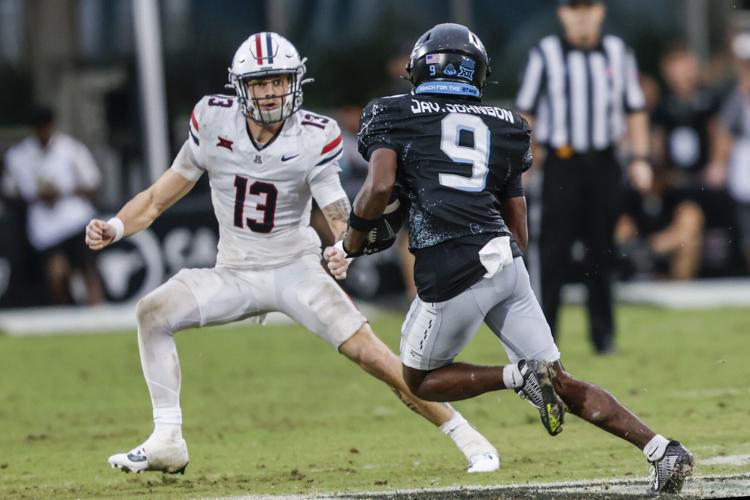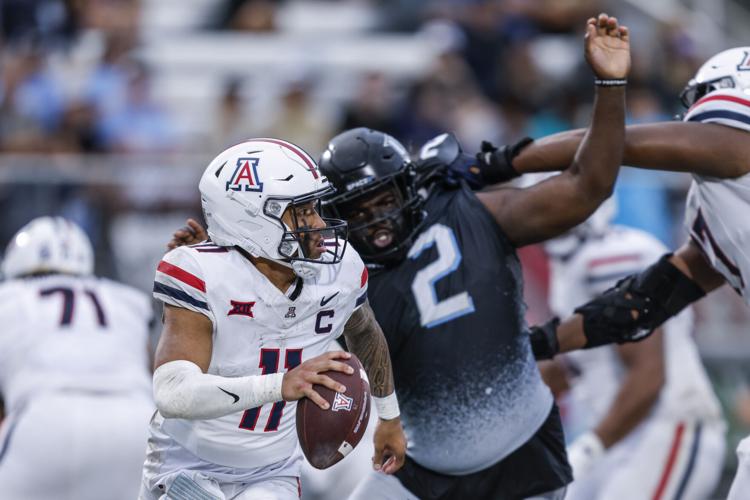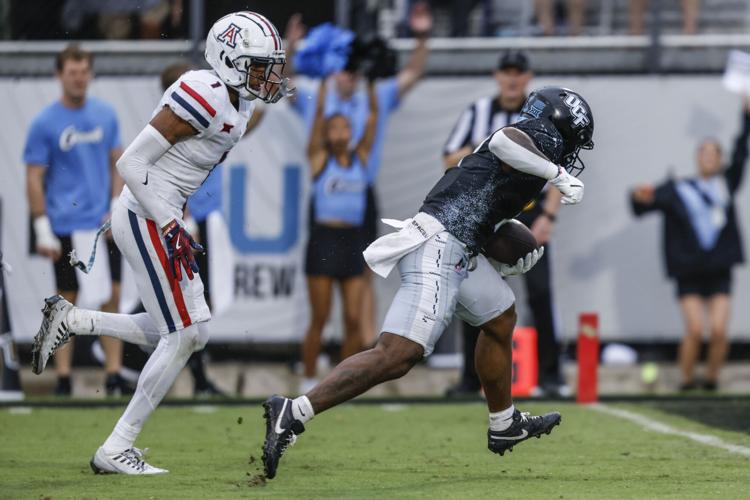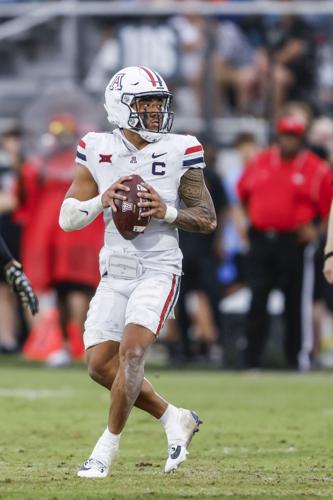Space is a dangerous place.
Our sci-fi heroes make it seem like an amusement ride, but it is not to be trifled with.

Michael Lev is a senior writer/columnist for the Arizona Daily Star, Tucson.com and The Wildcaster.
Arizona did not show up prepared for UCF’s “Space Game” on Saturday. The Wildcats got launched into the cold, unforgiving darkness — their bowl hopes likely dying in the process.
UCF 56, Arizona 12. It was as ugly as the score suggests.
The offense again struggled to get going. The banged-up defense completely collapsed.
The Wildcats couldn’t stop the run. They couldn’t tackle. They couldn’t prevent a Hail Mary.
It was an absolute mess. And it all falls at the feet of first-year coach Brent Brennan, whose approval rating among a disgruntled fan base continues to plummet.
How did things go from bad to worse for Arizona? Here are my top five takeaways from the Wildcats’ fifth consecutive defeat.
1. Indefensible

UCF running back RJ Harvey, right, scores against Arizona defensive back Tacario Davis during the second half of their game, Saturday, Nov. 2, 2024, in Orlando, Fla.
As you surely know by now, Arizona has been playing without three of its best defensive players — linebacker Jacob Manu and defensive backs Gunner Maldonado and Treydan Stukes. All have suffered season-ending injuries.
Coordinator Duane Akina has tried every trick in the playbook to patch the defense together and give the Wildcats a fighting chance.
It all fell apart on a rainy afternoon in Orlando, Florida.
Against Arizona’s dime defense — more on this in a moment — UCF ran the ball at will. With little penetration into the backfield, RJ Harvey danced, dodged, slithered and glided his way to 184 yards and three touchdowns. Quarterback Dylan Rizk — a fourth-string redshirt freshman not known for his running — added 55 yards on scrambles and zone-read keepers.
The Wildcats’ tackling was abysmal. At all levels of the defense, they struggled to get UCF ball-carriers to the ground. Arizona’s eye discipline and edge containment were just as deficient.
For the past two weeks, Akina has decided to stick with a dime defense featuring safety Dalton Johnson as a pseudo-linebacker, three down linemen and a roving defensive end. It didn’t work against West Virginia, which rushed for 203 yards. It really didn’t work against UCF, which finished with 308 yards on the ground.
I didn’t think using this scheme against the run-oriented Knights was a good idea. It wasn’t. Akina needed to have a plan B, and he needed to turn to it no later than the second quarter.
You would think a six-DB alignment would be effective against a Hail Mary. But Arizona managed to bungle that, too.
Did UCF tight end Randy Pittman Jr., the recipient of Rizk’s 48-yard heave, push Tacario Davis in the back? Replays showed a clear shove. But if two other UA defensive backs weren’t floating around — nowhere near the jump-ball scrum — it might not have mattered.
If any play epitomized this season from hell for Arizona, it was that one.
2. Inexplicable
The half-ending Hail Mary followed Arizona’s first touchdown, which made it 28-6. The Wildcats were set to get the ball to start the second half. If there was a glimmer of hope of rallying, this was it.
It’s also possible that the game already was lost because the head coach wasn’t playing to win.

Arizona defensive back Jack Luttrell, left, looks to tackle UCF wide receiver Ja'Varrius Johnson during the second half of their game, Saturday, Nov. 2, 2024, in Orlando, Fla.
Midway through the second quarter — with the score 21-0 and Arizona’s only stop coming on a missed UCF field goal — the Wildcats faced fourth-and-4 at their 49-yard line.
Brennan elected to punt, an absolutely inexplicable decision.
It was clear at that point that Arizona was having difficulty stopping UCF’s offense. On their previous possession, the Knights drove 99 yards, negating the excellent work of freshman punter Michael Salgado-Medina and his special-teams teammates.
The Wildcats desperately needed a score, or at least a spark. They weren’t backed up in their own territory. They needed only 4 yards — not 14. The downside risk was ... field position?
That moment represented a chance to shift momentum in Arizona’s favor. Brennan declined to take advantage of it.
Predictably, UCF scored on the next possession. And the next three after that.
Brennan said earlier in the season that he based many of his fourth-down decisions — going for it vs. field goal vs. punt — on his feel for the game at that particular time. Anyone could see that this one was rapidly slipping away.

Arizona quarterback Noah Fifita, left, scrambles away from UCF defensive tackle Lee Hunter during the second half of the Knights' win over the visiting Wildcats Nov. 2, 2024, in Orlando, Florida.
Punting at that juncture felt like conceding.
3. Familiar flaws
Even if the defense had played well, it’s been obvious for weeks that that unit isn’t at full capacity. It’s certainly not capable of carrying the offense. If anything, it needs to be the other way around.
The offense again did not hold up its end of the bargain.
Arizona had one positive play on its first possession. The Wildcats had only one play on their second possession, and it was the worst outcome imaginable: a fumble by Quali Conley deep in UA territory. UCF scored on the next play. The Bounce House was rocking.
Arizona’s next two possessions ended in punts. By the time Noah Fifita connected with Sam Olson for a touchdown late in the first half, the Wildcats trailed 28-0.
The offense’s problems were plentiful. The line couldn’t get any push in the run game. Arizona had 5 net rushing yards — not a typo — and yielded 10 tackles for loss.
Four of those TFLs were sacks of Fifita, who continues to hold the ball too long at times. The offense as a whole continues to have trouble recognizing and picking up blitzes.
Many of Arizona’s best passing plays — including the touchdown pass to Olson — came after the protection broke down and Fifita scrambled out of the pocket. If the offense is functioning better out of structure, that suggests that the structure is flawed. It’s been an issue since the early part of the season that Brennan and his staff have been unable to solve.
4. Hints of hope
After Arizona’s second touchdown — an absurd grab by Tetairoa McMillan, who tipped the ball to himself while being held on a fade to the right corner of the end zone — FS1’s cameras panned to the UA bench.
McMillan sat there alongside Fifita and quarterbacks coach Lyle Moevao. The players were studiously looking at their tablets.
The score was 42-12 with 8:02 left in the third quarter. But the faces of the franchise weren’t giving up.

Arizona quarterback Noah Fifita looks to pass against UCF during the second half of their game, Saturday, Nov. 2, 2024, in Orlando, Fla.
Fifita had a solid game, at least from a statistical standpoint, and he once again represented the offense in the postgame news conference. Fifita has told UA officials that he wants to speak after losses — and will give others the spotlight after wins. He is a young man of the highest character.
McMillan’s body language suffered at times earlier in the season, a reflection of his frustration over the offense’s struggles. He has addressed that problem since then, and FS1 captured him celebrating a long completion from Fifita to Chris Hunter.
You can’t question McMillan’s effort. He’s been going after every ball, and he refuses to go down upon first contact.
Hunter had the best game of his career with seven catches for 102 yards. His breakout has been one of the few bright spots during the losing streak.
But given the state of the program at the moment, I can’t help but think about Hunter pulling a Dorian Singer and leaving via the transfer portal. I have no inside information about such a possibility, but that’s where one’s mind goes during the dark times.

Arizona coach Brent Brennan talks to one of his assistants during the Wildcats’ 56-12 loss to UCF on Saturday, Nov. 2, 2024, in Orlando, Fla. Arizona suffered its fifth straight defeat.
5. ‘Unacceptable’
I reached out to UA athletic director Desireé Reed-Francois at the end of the game. She gave no indication that Brennan’s job is in jeopardy and provided the following statement:
“No one is more disappointed than Coach Brennan. You heard him say in his press conference that it’s unacceptable. Assessing every area will be key. We’re going to work together to get us on the right the path for long-term success. One thing I do know is that our student-athletes deserve our support.”
Reed-Francois fully understands how important it is to get football right. It’s the primary generator of revenue for the athletic department. She’s supporting Brennan for now but will undoubtedly mandate staff changes in the offseason, if not sooner.
It’s shocking that the subject of Brennan’s future is coming up less than a year into his tenure, but here we are. Following up a 10-3 season with a 3-9 campaign — a worst-case but realistic scenario — at the very least would put Brennan on the hot seat in 2025.
Money is a factor here, as always. Brennan would be owed in excess of $10 million if he were fired at season’s end. Arizona can’t afford that.
But Reed-Francois has to make a calculation to determine whether it’s worth it to keep moving forward with Brennan in charge. Much of the fan base has turned on him. What can be done to generate enthusiasm in the offseason? And without that enthusiasm, how can the UA hope to fill Arizona Stadium and provide the revenue the athletic department needs?
Reed-Francois has said she intends to go all in on revenue-sharing with student-athletes, to the tune of about $20 million per year. College athletics are in the midst of seismic changes and on the precipice of more. You don’t want to be left out if a football “super league” is formed, but Arizona’s place at the table is far from guaranteed.
Reed-Francois realizes what’s at stake. The Space Game only underscored the gravity of the situation.
Photos: Arizona Wildcats fall 56-12 to UCF Knights, Big 12 college football

UCF running back RJ Harvey, center, looses his helmet as he is tackled by the Arizona defense Nov. 2, 2024.

Central Florida quarterback Jacurri Brown, middle, runs the ball for a touchdown against Arizona during the first half in an NCAA college football game, Saturday, Nov. 2, 2024, in Orlando, Fla. (AP Photo/Kevin Kolczynski)

Arizona quarterback Noah Fifita (11) warms-up before an NCAA college football game against the Central Florida, Saturday, Nov. 2, 2024, in Orlando, Fla. (AP Photo/Kevin Kolczynski)

Central Florida quarterback Jacurri Brown (11) celebrates after running the ball for a touchdown against Arizona during the first half in an NCAA college football game, Saturday, Nov. 2, 2024, in Orlando, Fla. (AP Photo/Kevin Kolczynski)

Central Florida wide receiver Kobe Hudson (2) misses pass as he is defended by Arizona defensive back Genesis Smith, left, defensive back Jack Luttrell, left middle, and defensive back Dalton Johnson, right, during the first half in an NCAA college football game, Saturday, Nov. 2, 2024, in Orlando, Fla. (AP Photo/Kevin Kolczynski)

Central Florida quarterback Dylan Rizk (10) passes the ball against Arizona during the first half in an NCAA college football game, Saturday, Nov. 2, 2024, in Orlando, Fla. (AP Photo/Kevin Kolczynski)

Central Florida wide receiver Kobe Hudson, left, is tackled by Arizona defensive back Jack Luttrell, right, during the first half of an NCAA college football game, Saturday, Nov. 2, 2024, in Orlando, Fla. (AP Photo/Kevin Kolczynski)

Arizona defensive back Owen Goss (27), left, punches the ball out of the hands of Central Florida tight end Randy Pittman Jr., right, during the first half of an NCAA college football game, Saturday, Nov. 2, 2024, in Orlando, Fla. (AP Photo/Kevin Kolczynski)

Central Florida head coach Gus Malzahn watches his team before an NCAA college football game against Arizona, Saturday, Nov. 2, 2024, in Orlando, Fla. (AP Photo/Kevin Kolczynski)

Central Florida wide receiver Kobe Hudson, left, is tackled by Arizona defensive back Jack Luttrell, right, during the first half of an NCAA college football game, Saturday, Nov. 2, 2024, in Orlando, Fla. (AP Photo/Kevin Kolczynski)

Arizona defensive back Owen Goss (27), left, punches the ball out of the hands of Central Florida tight end Randy Pittman Jr., right, during the first half.

Central Florida quarterback Jacurri Brown, center left, celebrates with team mates after running the ball for a touchdown against Arizona during the first half in an NCAA college football game, Saturday, Nov. 2, 2024, in Orlando, Fla. (AP Photo/Kevin Kolczynski)

Arizona defensive back Tacario Davis, center, breaks free of block by Center Florida defensive tackle Ricky Barber (5), to tackle wide receiver Ja'Varrius Johnson (9) during the first half in an NCAA college football game, Saturday, Nov. 2, 2024, in Orlando, Fla. (AP Photo/Kevin Kolczynski)

Central Florida running back Myles Montgomery runs through the Arizona defense during the second half in an NCAA college football game, Saturday, Nov. 2, 2024, in Orlando, Fla. (AP Photo/Kevin Kolczynski)

UCF running back RJ Harvey, right, scores against Arizona defensive back Tacario Davis during the second half of their game, Saturday, Nov. 2, 2024, in Orlando, Fla.

Central Florida running back Johnny Richardson, center, runs between Arizona defensive back Jack Luttrell (13) and teammate defensive back Genesis Smith, right, during the second half in an NCAA college football game, Saturday, Nov. 2, 2024, in Orlando, Fla. (AP Photo/Kevin Kolczynski)

Arizona quarterback Noah Fifita scrambles away from Central Florida defensive tackle Lee Hunter (2) during the second half on Nov. 2, 2024, in Orlando, Fla.

Central Florida head coach Gus Malzahn encourages his team against Arizona during the second half in an NCAA college football game, Saturday, Nov. 2, 2024, in Orlando, Fla. (AP Photo/Kevin Kolczynski)

Arizona wide receiver Jeremiah Patterson is tackled by the Central Florida defense during the second half in an NCAA college football game, Saturday, Nov. 2, 2024, in Orlando, Fla. (AP Photo/Kevin Kolczynski)

Arizona coach Brent Brennan talks to one of his assistants during the Wildcats’ 56-12 loss to UCF on Saturday, Nov. 2, 2024, in Orlando, Fla. Arizona suffered its fifth straight defeat.

Arizona defensive back Jack Luttrell, left, looks to tackle UCF wide receiver Ja'Varrius Johnson during the second half of their game, Saturday, Nov. 2, 2024, in Orlando, Fla.

Arizona quarterback Noah Fifita looks to pass against UCF during the second half of their game, Saturday, Nov. 2, 2024, in Orlando, Fla.


